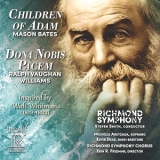Um sein sechzigjähriges Bestehen zu feiern, bestellte das Richmond Symphony (Virginia, US) ein Chorwerk beim amerikanischen Komponisten Mason Bates, der aus Richmond stammt.
Für sein Werk konzentriert er sich auf das Thema Schöpfung, mit Texten von Walt Whitman, Tolepe Menenak, Carl Sandburg sowie aus der Bibel. Eine ausführliche Beschreibung von Children of Adam findet der interessierte Leser am Schluss dieses Beitrags.
Das Werk ist ereignisreich in der Orchestrierung und abwechslungsreich in den Stimmungen. Die Komposition ist also durchaus kein permanenter Jubelgesang, sondern sie ist in den Motiven reich wie die Schöpfung selbst und die damit verbundene Fruchtbarkeit, hier spirituell und sinnlich, dort reflektiv, vorübergehend auch feierlich.
Im Gegensatz zum sehr farbigen und komplexen Orchesterpart ist der Chorpart im Choral und Hymnus verwurzelt. Schade ist, dass man wegen des überaus reichen Orchesterklangs den Text des gesungenen Wortes nicht mitbekommt und auf das Textheft angewiesen ist, um nachzuvollziehen, was gesungen wird.
Gekoppelt ist das rund 25 Minuten lange Stück mit dem Dona nobis pacem von Raph Vaughan Williams. Diese 1936 entstandene Kantate verwendet, genau wie das Werk von Bates, Texte von Walt Whitman, hat aber sonst keine Gemeinsamkeit mit dem neuen Stück. Sie ist geprägt von der Angst vor einem neuen Krieg und nimmt durchaus dramatische und bedrohliche, manchmal auch traurige Züge an.
Besonders beeindruckend ist, wenn in das zarte, vom Sopran gesungene Dona nobis pacem, unheilankündigende Trommeln einfallen und uns daran erinnern, dass Krieg unvermeidlich Elend und Verlust mit sich bringt.
Die Musik von Vaughan Williams ist ungleich ausdruckskräftiger als die von Bates, und das ergibt in dieser Liveaufnahme eine künstlerische Spannung, die die die ganze Kantate durchzieht. Die Expressivität aller Sätze bleibt unmittelbar effizient und lebendig. Steven Smith bringt seinen Chor, sein Orchester und die hervorragenden Solisten zu einem klanglich ausgewogenen, stets kraftvollen und spannenden Musizieren.
To celebrate its sixtieth anniversary, the Richmond Symphony (Virginia, US) commissioned a choral work from the American composer Mason Bates, a native of this city. He composed his work around the theme of the creation, with texts by Walt Whitman, Tolepe Menenak, Carl Sandburg and from the Bible. A detailed description can be found at the end of this article. The work is eventful in its orchestration and varied in its moods. It is by no means a permanent jubilation song, but it is musically rich and varied, here spiritual and sensual, there reflective, sometimes also solemn. In contrast to the very colorful and complex orchestral part, the choral part is rooted in the chorale and hymn. It is a pity that, because of the extremely rich orchestral sound, one does not understand the text and is dependent on the text booklet to realize what is sung. The 25-minute piece is coupled with the Dona nobis pacem by Raph Vaughan Williams. This cantata, written in 1936, uses texts by Walt Whitman, just like the work by Bates, but otherwise has nothing in common with the new piece. It is marked by the fear of a new war and is often dramatic, even threatening, but also sad. The music is much more expressive than that of Bates, which is particularly noticeable in in this exciting live recording.
The composer’s view:
« Children of Adam is a collection of exuberant celebrations of creation, from American poets to sacred and Native American texts. The title comes from a Whitman poem that appears throughout the work in the form of brief “fanfare intermezzos.” His celebrations of sensuality, considered provocative at the time, explore the connection of the body and the soul. Between these choral fanfares, each movement of the work offers a different perspective on creation.
Presented as a pair, the two Psalms offer colorful imagery of fertility, from crops to children – who are compared to olive shoots sprouting around the kitchen table. The harp is given a prominent role in the role of the “ten-stringed lyre” mentioned in the text. Later in the work, another biblical text comes in a darker vein, with the Book of Genesis’ description of the creation of the world conjured in music both frightening and, ultimately, impassioned. An interesting secular complement to these sacred texts are two poems by Carl Sanburg, who describes the creations of the Industrial Age in a highly reverent manner in “Prayers of Steel.”
The central movement of the cycle is a setting of ‘Tolepe Menenak’ (Turtle Island) from the Mattaponi Indians, whose reservation is close to my family’s farm in King & Queen County, Virginia. It was incredibly inspiring to explore a creation text whose roots are so close to that of my own family. The text, in native East Coast Algonquian, was sung to me by Sharon Sun Eagle at the reservation, where I visited with my first piano teacher Hope Armstrong Erb. She has continued to be a mentor to me, and to whom the work is dedicated. »






















